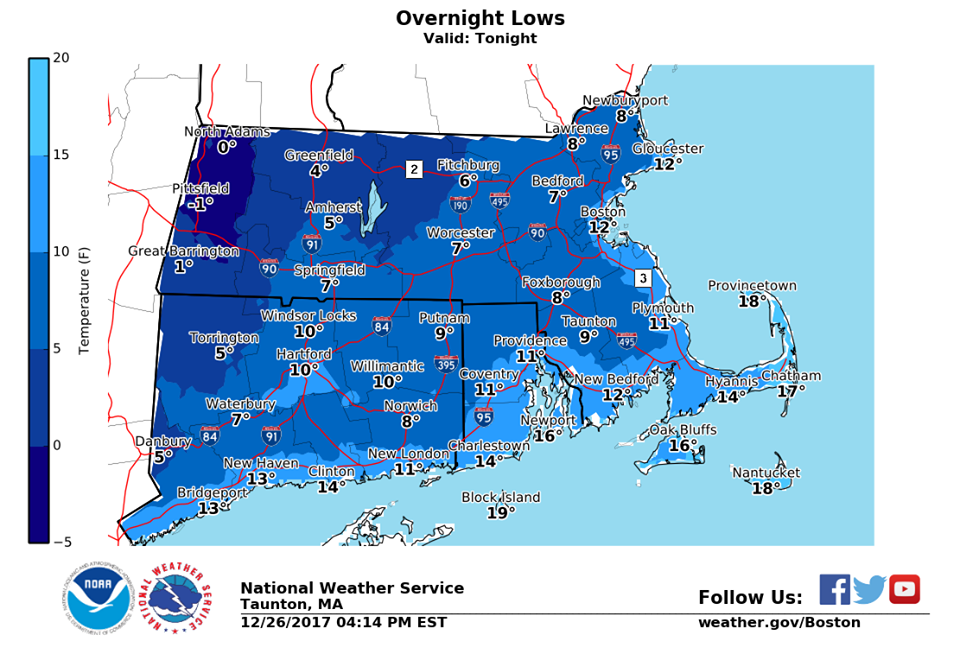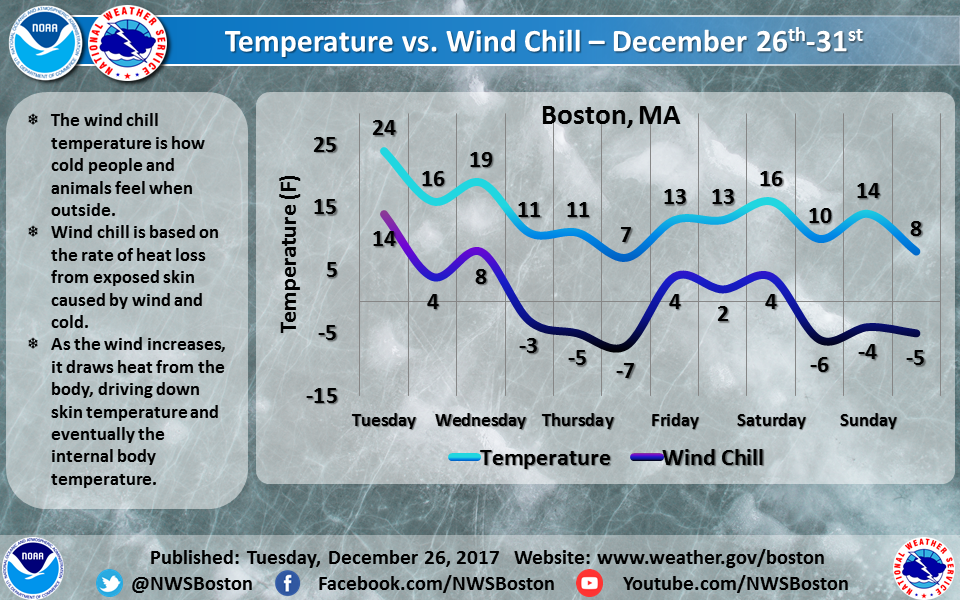Berkshires Face Frigid Temperatures This WeekStaff Reports,
06:34PM / Tuesday, December 26, 2017 | |
 The temperatures will be in the single digits and low teens for the next week or so. The temperatures will be in the single digits and low teens for the next week or so. |

Wind gusts could be up to 24 mph making it feel a lot colder.
PITTSFIELD, Mass. — It is getting cold this week - really cold.
According to the National Weather Service, temperatures will be below zero at night all week and be in the single-digits or low teens during the days.
The chill is expected to be "well below seasonal normals" for December, according to the National Weather Service, with arctic air coming into the area from Canada. The wind and cold aren't expected to break until next week.
"Strong arctic high pressure will move from the northern Plains tonight to the Great Lakes Wednesday and Thursday, then reach into western New England Friday. Very cold arctic air will dominate through the New Year holiday weekend. A coastal storm may develop during this weekend, but it remains uncertain if the system will track close enough to bring significant snow to the region," reads an advisory from the National Weather Service.
The coldest stretch is expected to start Wednesday evening and last until Friday morning. Thursday is expected to be the worst daytime with a temperature somewhere around 9 degrees with wind gusts of as much as 24 mph making it feel a whole lot colder.
"A Wind Chill Advisory may be needed for the interior, especially the higher terrain of the Worcester Hills and east slopes of the Berkshires as wind chills may dip to -15 to -20 in those locales," wrote the National Weather Service about Wednesday night.
The weather poses the threat of hypothermia. The Massachusetts Emergency Management Agency has previously released the following safety tips.
-Dress in several layers of loose-fitting, lightweight clothing instead of a single heavy layer. Outer garments should be tightly woven and water repellent. Wear a hat, mittens (not gloves), and sturdy waterproof boots to protect your extremities. Cover your mouth with a scarf to protect your lungs.
-Watch for signs of frostbite and hypothermia. Frostbite causes a loss of feeling and a pale appearance in extremities, such as fingers, toes, ear lobes or the tip of the nose. If symptoms are detected, seek medical help immediately.
-The warning signs of hypothermia include uncontrollable shivering, memory loss, disorientation, incoherence, slurred speech, drowsiness and apparent exhaustion. Get the victim to a warm location. If the person’s temperature drops below 95 degrees, seek immediate medical care.
-Have a well-stocked home Emergency Kit that includes a flashlight, sleeping bag or blanket, portable radio, extra batteries, a first aid kit, bottled water and non-perishable food. Add seasonal supplies to your emergency kit such as extra winter clothing and blankets.
-Make sure your car is properly winterized. Keep the gas tank at least half-full. Carry a Winter Emergency Car Kit including blankets, extra clothing, a flashlight with spare batteries, a can, waterproof matches (to melt snow for drinking water), non-perishable foods, windshields scraper, shovel, sand, towrope, and jumper cables in the trunk.
-Be a good neighbor. Check on family, friends, and neighbors, especially the elderly, those who live alone, those with medical conditions, and those who may need additional assistance.
-Limit outdoor time for your pets. Freezing temperatures are dangerous to animals as well as humans.
-Wrap pipes in insulation or layers of newspapers covered with plastic to keep them from freezing. Allow a trickle of warm water to run from a faucet that is farthest from your water meter or one that has frozen in the past. This will keep the water moving so that it cannot freeze. If pipes freeze, remove insulation, completely open all faucets and pour hot water over the pipes or wrap them with towels soaked in hot water, starting where they are most exposed to the cold. A hair dryer, used with caution, works well to thaw pipes.
-Although temperatures may be cold, bodies of water covered in ice are likely unsafe given recent temperature fluctuations. Residents are urged to stay off frozen bodies of water until ice is at least 4 inches thick.
-Ensure you have sufficient heating fuel, as well as alternate emergency heating equipment in case you lose electricity. When utilizing alternate heating sources, such as an emergency generator, your fireplace, wood stove, or space heater, take necessary safety precautions:
-Keep a fire extinguisher handy and ensure everyone knows how to use it properly.
-Never heat your home with a gas stove or oven or charcoal barbecue grill.
-Make sure all heating devices are properly ventilated and always operate a generator outdoors and away from your home. Improper heating devices can lead to dangerous carbon monoxide (CO) buildup in the home. Make sure you test smoke alarms and carbon monoxide detectors. Carbon monoxide is an odorless, colorless gas that can cause flulike illness or death. If you suspect carbon monoxide poisoning, call 911 immediately, get the victim to fresh air, and open windows.
-Keep anything that can burn at least three feet away from space heaters. See more winter heating safety tips from the Department of Fire Services.
If you need information on the location of open warming centers or shelters check with local authorities or call 2-1-1.
| 
